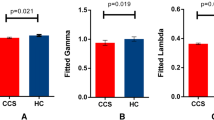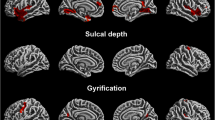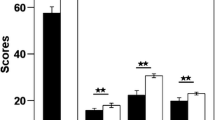Abstract
Objectives
To characterize interhemispheric functional and anatomical connectivity and their relationships with impulsive behaviour in codeine-containing cough syrup (CCS)-dependent male adolescents and young adults.
Methods
We compared volumes of corpus callosum (CC) and its five subregion and voxel-mirrored homotopic functional connectivity (VMHC) in 33 CCS-dependent male adolescents and young adults and 38 healthy controls, group-matched for age, education and smoking status. Barratt impulsiveness scale (BIS.11) was used to assess participant impulsive behaviour. Abnormal CC subregions and VMHC revealed by group comparison were extracted and correlated with impulsive behaviour and duration of CCS use.
Results
We found selective increased mid-posterior CC volume in CCS-dependent male adolescents and young adults and detected decreased homotopic interhemispheric functional connectivity of medial orbitofrontal cortex (OFC). Moreover, impairment of VMHC was associated with the impulsive behaviour and correlated with the duration of CCS abuse in CCS-dependent male adolescents and young adults.
Conclusions
These findings reveal CC abnormalities and disruption of interhemispheric homotopic connectivity in CCS-dependent male adolescents and young adults, which provide a novel insight into the impact of interhemispheric disconnectivity on impulsive behaviour in substance addiction pathophysiology.
Key Points
• CCS-dependent individuals (patients) had selective increased volumes of mid-posterior corpus callosum
• Patients had attenuated interhemispheric homotopic FC (VMHC) of bilateral orbitofrontal cortex
• Impairment of VMHC correlated with impulsive behaviour in patients
• Impairment of VMHC correlated with the CCS duration in patients




Similar content being viewed by others
References
Tomasch J (1954) Size, distribution, and number of fibres in the human corpus callosum. Anat Rec 119:119–135
Pfefferbaum A, Sullivan EV (2002) Microstructural but not macrostructural disruption of white matter in women with chronic alcoholism. Neuroimage 15:708–718
van Ewijk H, Groenman AP, Zwiers MP et al (2015) Smoking and the developing brain: altered white matter microstructure in attention-deficit/hyperactivity disorder and healthy controls. Hum Brain Mapp 36:1180–1189
Qiu Y, Jiang G, Su H et al (2013) Progressive white matter microstructure damage in male chronic heroin dependent individuals: a DTI and TBSS study. PLoS One 8, e63212
Bora E, Yucel M, Fornito A et al (2012) White matter microstructure in opiate addiction. Addict Biol 17:141–148
Ma L, Hasan KM, Steinberg JL et al (2009) Diffusion tensor imaging in cocaine dependence: regional effects of cocaine on corpus callosum and effect of cocaine administration route. Drug Alcohol Depend 104:262–267
Lin F, Zhou Y, Du Y et al (2012) Abnormal white matter integrity in adolescents with internet addiction disorder: a tract-based spatial statistics study. PLoS One 7, e30253
Shek DT, Lam CM (2006) Adolescent cough medicine abuse in Hong Kong: implications for the design of positive youth development programs in Hong Kong. Int J Adolesc Med Health 18:493–503
Luders E, Thompson PM, Toga AW (2010) The development of the corpus callosum in the healthy human brain. J Neurosci 30:10985–10990
Squeglia LM, Gray KM (2016) Alcohol and drug use and the developing brain. Curr Psychiatry Rep 18:1–10
Squeglia LM, Jacobus J, Tapert SF (2009) The influence of substance use on adolescent brain development. Clin EEG Neurosci 40:31–38
De Lacoste MC, Kirkpatrick JB, Ross ED (1985) Topography of the human corpus callosum. J Neuropathol Exp Neurol 44:578–591
Abe O, Masutani Y, Aoki S et al (2004) Topography of the human corpus callosum using diffusion tensor tractography. J Comput Assist Tomogr 28:533–539
Patton JH, Stanford MS, Barratt ES (1995) Factor structure of the Barratt impulsiveness scale. J Clin Psychol 51:768–774
Yao S, Yang H, Zhu X et al (2007) An examination of the psychometric properties of the Chinese version of the Barratt Impulsiveness Scale, 11th version in a sample of Chinese adolescents. Percept Mot Skills 104:1169–1182
Fischl B (2012) FreeSurfer. Neuroimage 62:774–781
Fischl B, Salat DH, Busa E et al (2002) Whole brain segmentation: automated labeling of neuroanatomical structures in the human brain. Neuron 33:341–355
Ji GJ, Zhang Z, Xu Q, Zang YF, Liao W, Lu G (2014) Generalized tonic-clonic seizures: aberrant interhemispheric functional and anatomical connectivity. Radiology 271:839–847
Yan CG, Cheung B, Kelly C et al (2013) A comprehensive assessment of regional variation in the impact of head micromovements on functional connectomics. Neuroimage 76:183–201
Yan CG, Zang YF (2010) DPARSF: a MATLAB toolbox for "pipeline" data analysis of resting-state fMRI. Front Syst Neurosci 4:13
Zuo XN, Kelly C, Di Martino A et al (2010) Growing together and growing apart: regional and sex differences in the lifespan developmental trajectories of functional homotopy. J Neurosci 30:15034–15043
Song XW, Dong ZY, Long XY et al (2011) REST: a toolkit for resting-state functional magnetic resonance imaging data processing. PLoS One 6, e25031
Herron TJ, Kang X, Woods DL (2012) Automated measurement of the human corpus callosum using MRI. Front Neuroinform 6
Ojemann JG, Akbudak E, Snyder AZ, McKinstry RC, Raichle ME, Conturo TE (1997) Anatomic localization and quantitative analysis of gradient refocused echo-planar fMRI susceptibility artifacts. Neuroimage 6:156–167
LaMantia A, Rakic P (1990) Axon overproduction and elimination in the corpus callosum of the developing rhesus monkey. J Neurosci 10:2156–2175
Bressoud R, Innocenti GM (1999) Typology, early differentiation, and exuberant growth of a set of cortical axons. J Comp Neurol 406:87–108
Halloran MC, Kalil K (1994) Dynamic behaviors of growth cones extending in the corpus callosum of living cortical brain slices observed with video microscopy. J Neurosci 14:2161–2177
Raine A, Lencz T, Taylor K et al (2003) Corpus callosum abnormalities in psychopathic antisocial individuals. Arch Gen Psychiatry 60:1134–1142
Narr KL, Thompson PM, Sharma T, Moussai J, Cannestra AF, Toga AW (2000) Mapping morphology of the corpus callosum in schizophrenia. Cereb Cortex 10:40–49
Downhill JE, Buchsbaum MS, Wei T et al (2000) Shape and size of the corpus callosum in schizophrenia and schizotypal personality disorder. Schizophr Res 42:193–208
Preis S, Steinmetz H, Knorr U, Jancke L (2000) Corpus callosum size in children with developmental language disorder. Brain Res Cogn Brain Res 10:37–44
Tang AK, Tang WK, Liang HJ, Chan F, Mak SC, Ungvari GS (2012) Clinical characteristics of cough mixture abusers referred to three substance abuse clinics in Hong Kong: a retrospective study. East Asian Arch Psychiatry 22:154–159
Giedd JN, Blumenthal J, Jeffries NO et al (1999) Development of the human corpus callosum during childhood and adolescence: a longitudinal MRI study. Prog Neuropsychopharmacol Biol Psychiatry 23:571–588
Thompson PM, Giedd JN, Woods RP, MacDonald D, Evans AC, Toga AW (2000) Growth patterns in the developing brain detected by using continuum mechanical tensor maps. Nature 404:190–193
Squeglia LM, Tapert SF, Sullivan EV et al (2015) Brain development in heavy-drinking adolescents. Am J Psychiatry 172:531–542
Bava S, Jacobus J, Thayer RE, Tapert SF (2013) Longitudinal changes in white matter integrity among adolescent substance users. Alcohol Clin Exp Res 37:E181–E189
Jacobus J, Squeglia LM, Bava S, Tapert SF (2013) White matter characterization of adolescent binge drinking with and without co-occurring marijuana use: a 3-year investigation. Psychiatry Res 214:374–381
Jacobus J, Squeglia LM, Infante MA, Bava S, Tapert SF (2013) White matter integrity pre-and post marijuana and alcohol initiation in adolescence. Brain Sci 3:396–414
Lebel C, Caverhill-Godkewitsch S, Beaulieu C (2010) Age-related regional variations of the corpus callosum identified by diffusion tensor tractography. Neuroimage 52:20–31
Tanabe J, Tregellas JR, Dalwani M et al (2009) Medial orbitofrontal cortex gray matter is reduced in abstinent substance-dependent individuals. Biol Psychiatry 65:160–164
Ersche KD, Fletcher PC, Lewis SJ et al (2005) Abnormal frontal activations related to decision-making in current and former amphetamine and opiate dependent individuals. Psychopharmacology (Berl) 180:612–623
Botelho MF, Relvas JS, Abrantes M et al (2006) Brain blood flow SPET imaging in heroin abusers. Ann N Y Acad Sci 1074:466–477
Volkow ND, Wang GJ, Ma Y et al (2005) Activation of orbital and medial prefrontal cortex by methylphenidate in cocaine-addicted subjects but not in controls: relevance to addiction. J Neurosci 25:3932–3939
Qiu YW, Han LJ, Lv XF et al (2011) Regional homogeneity changes in heroin-dependent individuals: resting-state functional MR imaging study. Radiology 261:551–559
Yw Q, Jiang G, Ma Xf SHH, Xf L, Fz Z (2016) Aberrant interhemispheric functional and structural connectivity in heroin‐dependent individuals. Addict Biol. doi:10.1111/adb.12387
Qiu Y, Lv X, Su H et al (2013) Reduced regional homogeneity in bilateral frontostriatal system relates to higher impulsivity behavior in codeine-containing cough syrups dependent individuals. PLoS One 8, e78738
Qiu YW, Lv XF, Jiang GH et al (2014) Reduced ventral medial prefrontal cortex (vmPFC) volume and impaired vmPFC-default mode network integration in codeine-containing cough syrups users. Drug Alcohol Depend 134:314–321
Qiu YW, Su HH, Lv XF, Jiang GH (2015) Abnormal white matter integrity in chronic users of codeine-containing cough syrups: a tract-based spatial statistics study. AJNR Am J Neuroradiol 36:50–56
Bechara A, Damasio H, Tranel D, Damasio AR (1997) Deciding advantageously before knowing the advantageous strategy. Science 275:1293–1295
Kringelbach ML (2005) The human orbitofrontal cortex: linking reward to hedonic experience. Nat Rev Neurosci 6:691–702
Kelly C, Castellanos FX (2014) Strengthening connections: functional connectivity and brain plasticity. Neuropsychol Rev 24:63–76
Acknowledgements
This work was supported by the grants from the Natural Scientific Foundation of China [Grant No. 81201084, 81560283], the Natural Scientific Foundation of Jiangxi Province, China [Grant No. 20151BAB205049], and Planned Science and Technology Project of Guangdong Province, China [Grant No. 2011B031800044]. We thank LetPub (www.letpub.com) for its linguistic assistance during the preparation of this manuscript.
The scientific guarantor of this publication is Professor Junzhang Tian. The authors of this manuscript declare no relationships with any companies whose products or services may be related to the subject matter of the article. No complex statistical methods were necessary for this paper. Institutional review board approval was obtained. Written informed consent was obtained from all subjects (patients) in this study. No study subjects or cohorts have been previously reported. Methodology: prospective, case–control study, performed at one institution.
Author information
Authors and Affiliations
Corresponding author
Electronic supplementary material
Below is the link to the electronic supplementary material.
ESM 1
(DOCX 197 kb)
Rights and permissions
About this article
Cite this article
Qiu, Yw., Lv, Xf., Jiang, Gh. et al. Larger corpus callosum and reduced orbitofrontal cortex homotopic connectivity in codeine cough syrup-dependent male adolescents and young adults. Eur Radiol 27, 1161–1168 (2017). https://doi.org/10.1007/s00330-016-4465-5
Received:
Revised:
Accepted:
Published:
Issue Date:
DOI: https://doi.org/10.1007/s00330-016-4465-5




